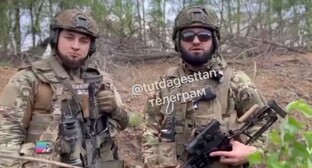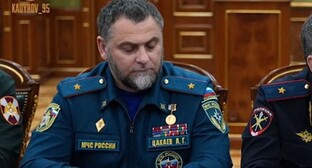22 September 2003, 21:39
Battle for Caucasus
The Battle for the Caucasus (there is an equivalent term in the German historiography - Kaukasusschlacht or Kampf um dem Kaukasus) is the name of the military action in the N. Caucasus taken by the Armed Forces of the USSR and Germany (as well as its satellites, primarily Romania and Slovakia) in 1942-43.
The Soviet Headquarters of the High Command committed a fatal error by awaiting a second German advance on Moscow in spring and summer 1942. The key direction of the German advance on Moscow was southern, with the aim of capturing Stalingrad (present-day Volgograd) and the Caucasus. The defeat of the Soviet troops in the Crimea and near Kharkov allowed the Wehrmacht on July 23, 1942, to take Rostov and crossed the lower Don on July 25 (this date is considered the start of the Battle). On the part of Germany, military operations in the N. Caucasus were carried out by an "A" body of troops (or "group of armies" in the Russian terminology) commanded by General Field Marshal Wilhelm List (in November replaced by Colonel-General Ewald von Kleist). The "A" body of troops was opposed by the troops of the Soviet North Caucasian Front (commanded by General of the Army Semyon Budenny) and, from September 1942, the Transcaucasian Front (commanded by General of the Army Ivan Tiulenev) to which the defeated units of the North Caucasian Front were re-subordinated (reorganized as the Black Sea body of troops commanded by Colonel-General Yakov Cherevichenko and the Northern body of troops commanded by Lieutenant-General Ivan Maslennikov). The Black See Fleet (commanded by Vice Admiral Philip Oktyabrsky) and the Azov Military Flotilla (commanded by Rear Admiral Sergey Gorshkov) operated along the Black See coast.
In August the German troops took Stavropol, Krasnodar, Maikop, Elista, Cherkessk, Nalchik, Novorossiysk, and Mozdok. The German flag was hoisted on Mount Elbrus on August 21.
In late September through early October, the Soviet command was able to organize successful defense along the Main Caucasian Range and the Terek River. The German advance got exhausted and the front stabilized along the following line: the southern outskirts of Novorossiysk - Goryachy Klyuch - passes of the Main Caucasian Range - Alagir - the northern outskirts of Vladikavkaz (the city was not invaded) - Malgobek - Ishcherskaya - Achikulak. Further in the north the frontline was practically absent (the German troops did not reach the Caspian Sea). Completely occupied were the Rostov region, Cherkesia, Karachay, Adygeya, and the Stavropol territory; almost completely the Krasnodar territory (except for the Black Sea shore behind Novorossiysk), Kalmykia (except for Chernye Zemli), Kabardino-Balkaria (except for its southeastern part), and North Ossetia (except for Vladikavkaz and its southern part). In Checheno-Ingushetia, the Germans were able to take Malgobek and Ishcherskaya in the northwest. Just a few reconnaissance groups penetrated Dagestan's northern steppes, so there was no military action here.
The Germans introduced military government on the occupied territory, carried out by "field commandant's offices" (Feldkommandanturen) along with inferior "local commandant's offices" (Ortskommandanturen) and "disposition commandant's offices" (Truppenstandortkommandanturen). Occupation authorities used collaborationists from among the natives and created controlled bodies of local civil government. In respect to the non-Slavic native population and the Cossacks, they encouraged the operation of various anti-Soviet nationalist and separatist organizations and enlistment to the "voluntary units" of the Wehrmacht.
Yet the Germans lacked specific and actually applied policy for the Caucasus - Hitler had just approved the general idea of creating a "reichskommissariat" of the Caucasus as part of Alfred Rosenberg's East Ministry (Reichskommissariat Kaukasus in das Ostministerium).
The Battle for Stalingrad that ended with the surrender of Friedrich Paulus's troops on February 2, 1943, determined the destiny of the Caucasus. The Wehrmacht's High Command decided not to keep hold of the Caucasus and pull the "A" body of troops out. By late March, practically the entire occupied territory was freed, with the exception of the area of Novorossiysk - Anapa - Temriuk - Taman. Since the key battles in spring and summer 1943 went on beyond the N. Caucasus, Novorossiysk was freed in September. The last German formations were evacuated from the Taman Peninsula on October 9, 1943. This date is considered the end of the Battle for the Caucasus.
Author: Koreniako, Vladimir




